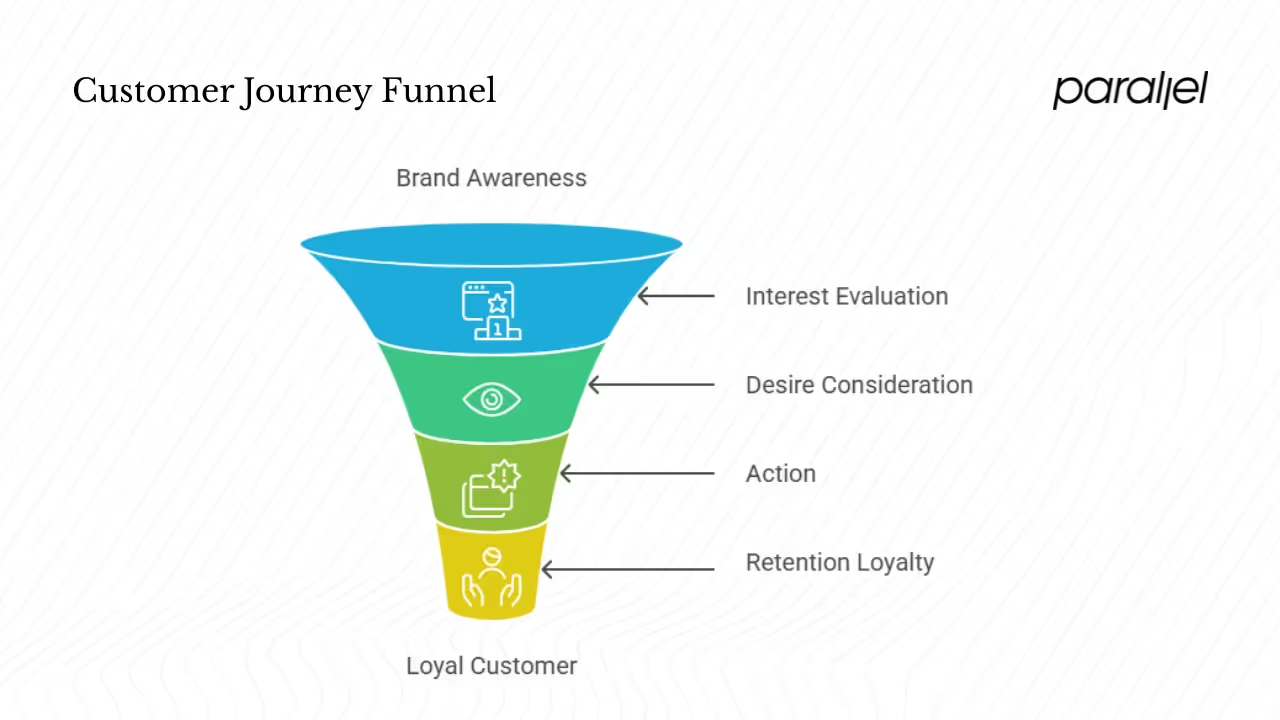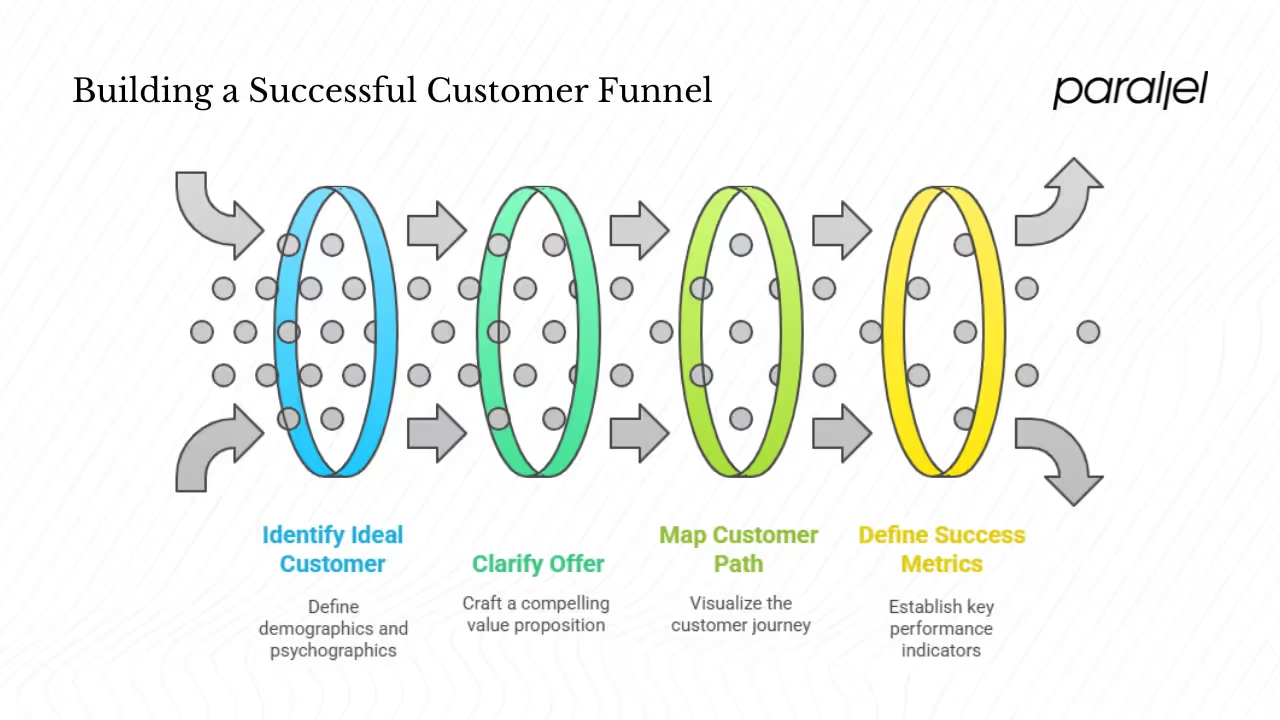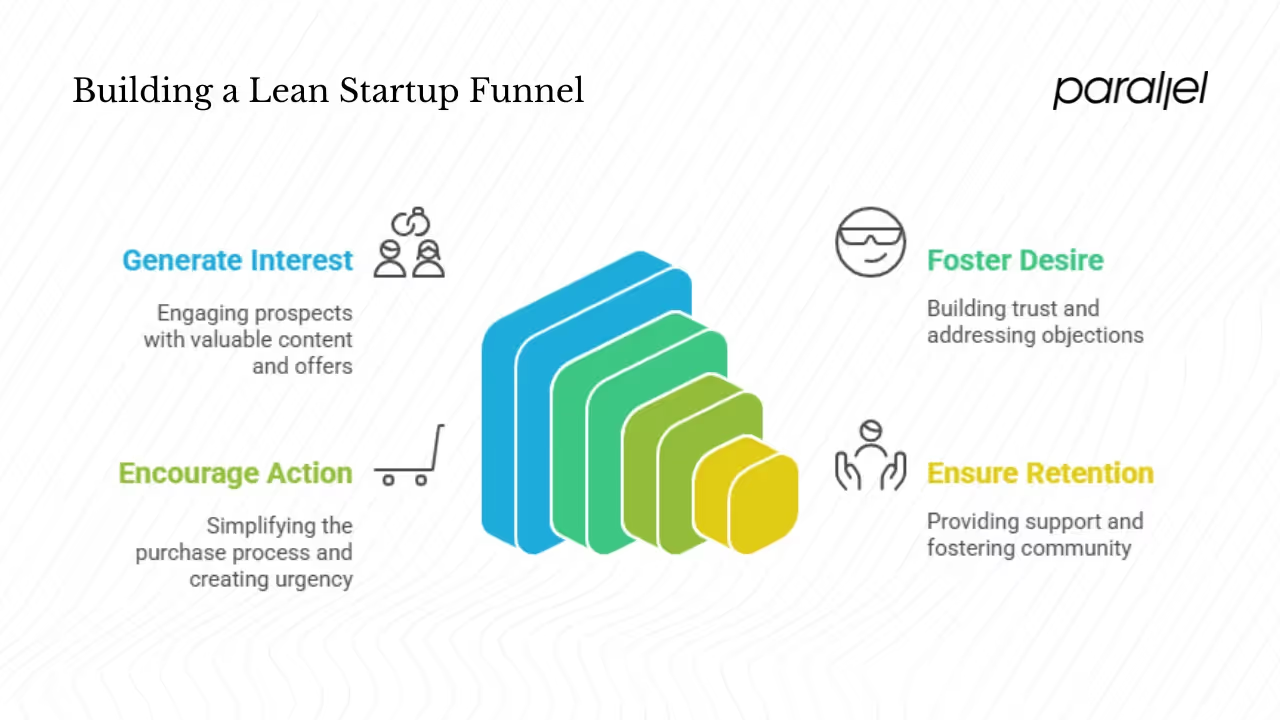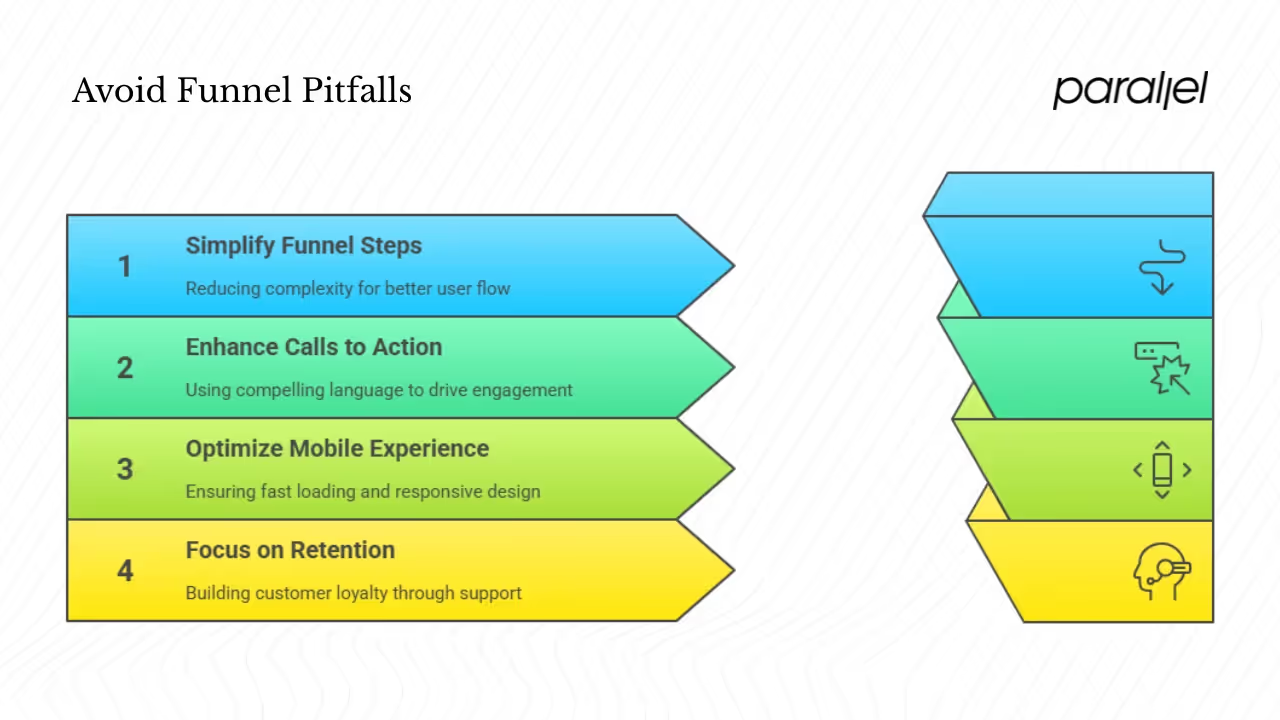How to Build a Marketing Funnel: Guide (2026)
Learn how to build an effective marketing funnel, from awareness and consideration to conversion, to optimize customer journeys.

When you’re running a young product company, every touchpoint counts. With limited capital and high stakes, converting curious visitors into loyal customers is both an art and a science. That’s where a marketing funnel comes in.
It’s a way to picture the steps that people take from first discovering your offering to becoming repeat buyers. A sales funnel is a similar picture, but it focuses on individual deals and person‑to‑person outreach. A marketing funnel starts earlier, drawing an audience in with content and ads, then nurturing them until they are ready to buy.
In this piece I’ll share how to build a funnel from scratch, avoid common missteps, and measure what matters. By the end you’ll have a step‑by‑step playbook grounded in data and my own experience helping software teams at Parallel.
Quick Answer: How to Build a Marketing Funnel in 2026
To build a marketing funnel in 2026, follow five key stages:
- Awareness – Attract relevant visitors through content, SEO, or ads
- Interest / Evaluation – Capture leads with landing pages and valuable offers
- Desire / Consideration – Nurture prospects using social proof and email sequences
- Action – Convert them into customers with clear CTAs and smooth signup flows
- Retention & Loyalty – Keep them engaged with onboarding, support, and upsells
Start with one simple path (e.g., ad → landing page → trial), track performance at each stage, test improvements monthly, and scale what works
What Is a Marketing Funnel?
A marketing funnel is a model that describes how people move from awareness of a brand to taking action, such as signing up or buying. It’s wide at the top and narrow at the bottom because many prospects begin the path but only some become customers. Research from Leadfeeder sums it up well: a sales funnel is a visual representation of the path made by potential customers as they move from first hearing about a product to purchase. A marketing funnel starts even earlier, focusing on building awareness and drawing visitors toward your offering, while the sales funnel kicks in when prospects are ready to talk to a representative.
In practice, a marketing funnel has several stages:
- Awareness – People notice your brand through SEO, content, social posts or referrals. They’re looking for a solution but aren’t yet comparing vendors.
- Interest or evaluation – Prospects explore your site, read articles, watch videos and consider if your product solves their problem.
- Desire or consideration – They compare options, read testimonials, and start to envision using your product.
- Action – They sign up for a trial, book a demo or purchase.
- Retention and loyalty – They continue using the product, give feedback and potentially buy more.

Some companies add more stages (intent or evaluation), but the principle is the same: guide people from discovery to loyal usage. The sales pipeline is different. While the funnel focuses on the buyer’s experience, the pipeline charts actions taken by sales teams: prospecting, qualifying leads, negotiation, demos and closing. As Coupler.io notes, marketing funnels rely on content and ads to reach broad groups, whereas sales funnels involve high‑touch conversations and negotiations. A marketing funnel is heavy on blog posts, webinars and nurturing campaigns; a sales funnel is heavy on calls, demos and proposals. Understanding both models helps you decide where to invest your time.
A user journey map (or customer experience map) is related but distinct. It’s a visual tool that captures how a user interacts with your website or product, including their actions, feelings and obstacles at every stage. While a simple funnel tracks conversion steps, a journey map looks at the entire experience—from first click to purchase—and highlights motivations, pain points and touchpoints. For our purposes, the funnel is a high‑level view of conversion steps, while a journey map gives deeper empathy for the user and helps you refine details of each stage.
Prepare Before You Build — Strategy & Planning
Before you sketch your first funnel, get clear on whom you’re serving and why they should care. Many founders jump straight into ads or landing pages without understanding their audience, which leads to poor conversion.

1) Identify your ideal customer – Start with demographic details (age, role, company size) and go deeper into psychographics: values, motivations, and the problem they need to solve. Tom Amitay’s guide to user journey mapping points out that a detailed user profile includes job titles, industry, goals and challenges. Speak with current users, run surveys, and interview prospects to hear why they chose you or why they hesitated. Competitor research can reveal gaps in the market—what alternatives exist, what they charge, and how their onboarding feels.
2) Clarify your offer – What benefit makes someone move from curious to committed? Your value proposition should address a pressing pain. If it’s a SaaS tool that saves hours of manual work, quantify those hours. If it’s a design service, show how it increases signups. Many teams overcomplicate their message; keep it simple and focused.
3) Map the customer path – Imagine what your audience sees, thinks, and does at each stage. Use the journey map structure: how they find you, what they do on your site, their emotions along the way, what convinces them to take the next step, and what hurdles they face. You can sketch this on a whiteboard or use software. The goal is to anticipate their questions and design content and messaging that answers them.
4) Define success metrics – Decide early which numbers matter. At the top of the funnel, track web traffic, impressions and engagement (likes, shares). In the middle, measure lead generation rates and the quality of those leads. The WPFunnels guide suggests tracking traffic sources, engagement metrics (impressions, social metrics) and bounce rate at the awareness stage. In the middle, monitor lead generation rate, lead quality and engagement rate. At the bottom, look at conversion rate and retention. Determine acceptable drop‑off between stages and set goals for improvement. With a plan in place, you’re ready to build.
Funnel Stages & Building Blocks
Each stage of the funnel requires different tactics and tools. Below I outline what to do at each stage, along with practical examples and suggestions on how to build a funnel that works for a lean startup.

Awareness — Top of Funnel (ToFu)
Traffic sources – At this stage you want as many relevant people as possible to know you exist. Organic channels—search‑engine‑optimized articles, guest posts and shareable social media posts—often provide steady traffic over time. Paid channels like search ads, sponsored newsletters or influencer collaborations can give a quick boost. Referral programs encourage existing users to invite others.
Content marketing – Publish helpful posts, videos and infographics that answer common questions in your space. For example, if you build analytics software, share how‑to guides for tracking metrics. Use keywords naturally. Each piece should include a call‑to‑action inviting readers to subscribe or sign up. Keep your CTAs clear and simple, since research shows pages that load in one second have conversion rates 2.5 times higher than those loading in five seconds.
Landing pages – Create a clean, distraction‑free page for each campaign. The goal is to capture contact information or prompt a micro‑conversion such as signing up for a newsletter. Use headlines that speak directly to the problem, short copy that explains the benefit, and a clear CTA. Top landing pages convert at 5.31% or higher, so aim for simple designs that load quickly.
Interest / Evaluation — Middle of Funnel (MoFu)
Lead generation – Offer value in exchange for contact details. Examples include white papers, cheat sheets, mini‑courses or webinars. Provide real insight—not just fluff—to build trust. When someone downloads a resource, send them to a thank‑you page with a relevant next step, such as booking a demo.
Lead capture – Use forms on landing pages, chatbots or interactive tools to collect names and emails. Keep fields to a minimum—asking only for an email address can lift conversions. Use a strong CTA on the button (“Get the guide” versus “Submit”).
Automation – Once you have a lead’s details, use automation to send a series of messages. Start with a welcome email, then drip useful content over several days. Segment leads based on their behavior (e.g., opened the guide, visited the pricing page) and personalize messages accordingly. According to the WPFunnels guide, tracking lead generation rate and engagement rate helps determine if your content resonates.
Desire / Consideration
Social proof and comparisons – Show that others trust you. Display testimonials, reviews and case studies on your site and inside emails. If prospects are weighing you against competitors, provide comparison pages or tools that make the decision easier.
Email sequences – Build a nurture sequence that educates and addresses objections. For example, one email might explain how your product integrates with popular tools; another might share a client success story. Keep messages human and conversational.
Experiments – Test different headlines, images, CTAs and offers. A/B testing helps you discover which version converts better. For instance, the Amra and Elma report notes that personalized calls to action perform 202% better than generic ones. So test personalization across your pages and emails.
Action — Bottom of Funnel (BoFu)
Simplify the process – Make it easy to buy or sign up. Remove unnecessary form fields and require as little friction as possible. Provide multiple payment methods and a secure checkout. If you’re offering a free trial, set up one‑click registration. Use clear pricing and avoid hidden fees.
Urgency and scarcity – If appropriate, offer limited‑time discounts or bonuses. Use them judiciously; false urgency erodes trust.
Onboarding – After someone signs up or buys, ensure they see value quickly. Use onboarding emails, in‑app guides or short videos to help them succeed. The faster they experience success, the more likely they are to stick around.
Post‑Action — Retention & Loyalty
Support and follow‑up – Provide excellent customer service and check in regularly. Send tips for getting more out of your product. Ask for feedback and make improvements based on what you learn.
Bring them back – Use content to keep customers engaged. Share product updates, new resources or upcoming events. Offer upsells or cross‑sells when they’re genuinely useful. The Amra and Elma statistics show that pages with social proof have higher conversion rates than those without, and that email traffic converts at 13%—so nurturing existing customers via email remains powerful.
Community – Encourage customers to join groups or forums where they can ask questions and share experiences. Building a network around your product fosters loyalty and referrals.
By combining these tactics, you’ve started to outline how to build a funnel that takes people from initial interest to loyal usage. Keep your message consistent at every stage and ensure each step leads naturally to the next.
Funnel Stage Summary Table
Tools & Automation
Modern software makes it easier for small teams to manage complex funnels. Here are a few categories to consider when thinking about how to build a funnel with lean resources:
- Automation platforms – Tools like HubSpot, Mailchimp or Customer.io help you send targeted emails, segment contacts and track behavior. They allow you to tag leads based on actions, trigger messages automatically and route hot prospects to your calendar.
- Email services – Effective emails are clear, personal and direct. Use a friendly subject line, short paragraphs, and one main CTA. Personalization increases engagement; for instance, personalized CTAs can improve conversion by over 200%.
- Landing page builders – Services such as Carrd, Webflow or Unbounce offer templates and drag‑and‑drop editors. Look for pages that load quickly and work well on mobile devices; e‑commerce sites that load within three seconds convert at much higher rates.
- Analytics tools – Platforms like Google Analytics 4 and Mixpanel provide custom funnel reports. These reports show how people move through your pages, where they drop off, and which sources drive conversions. Heatmaps from services like Hotjar can show where users click or scroll.
When choosing tools, start simple. A basic email service and a landing page builder are enough for a homemade funnel. Add more automation as your volume grows.
Measurement & Optimization
Measuring and optimizing your funnel is as important as building it. Without data you won’t know which parts need improvement.
Track metrics at each stage – At the top of the funnel, watch page views, unique visitors, social shares and bounce rate. A high bounce rate can mean your headline doesn’t match the search intent or that your page loads slowly. In the middle, track lead generation rate, lead quality and engagement rate. At the bottom, monitor conversion rate (how many leads become customers) and churn (how many leave after buying). The Ruler Analytics study found that the average conversion rate across fourteen industries is 2.9%, but rates vary by industry and product price. The Amra and Elma report notes that average sales funnel conversion is about 2.35%, with top performers reaching 5.31%.
Analyze drop‑offs – Plot your funnel as a series of numbers: visitors → leads → qualified leads → customers. Look for steps where a large percentage drop off. If many visitors land on your blog but few visit your pricing page, maybe your CTA is buried or your content doesn’t build enough interest.
Test hypotheses – Use A/B testing to compare different headlines, button colours, layouts or offers. Focus on one element at a time and gather enough data to see a clear signal. For example, test a personalized CTA against a generic one and observe the difference. The WPFunnels guide encourages experimentation at each stage to find what resonates.
Iterate often – Funnels are not static. As you launch new features or target new segments, your audience’s needs change. Set a cadence (e.g., monthly) to review metrics and adjust content, emails or ads. Over time, small improvements compound.
Common Pitfalls & How to Avoid Them?
Even seasoned teams fall into traps when building funnels. Here are some mistakes I’ve seen and how to sidestep them:
- Rushing optimization before product‑market fit – No amount of funnel tweaking will fix a product people don’t want. Validate your core offer with interviews and small tests before scaling.
- Overly complex funnels – Early‑stage startups sometimes build ten‑step sequences with multiple upsells and cross‑sells. Simplicity wins at first. Start with a three‑step path (ad → landing page → sign‑up) and expand once you see traction.
- Weak calls to action – Generic buttons like “Submit” or “Learn more” don’t inspire action. Use clear, benefit‑driven language like “Start free trial” or “Get my report now.”
- Ignoring mobile experience – Many visitors come from mobile devices, yet some sites load slowly or hide the CTA behind pop‑ups. According to Amra and Elma, e‑commerce sites that load in one second convert far better than those loading in five seconds, and mobile‑responsive pages outperform non‑responsive ones. Make sure your pages work well on phones.
- Neglecting retention – Some founders obsess over acquisition but forget to support customers after purchase. Investing in onboarding, support and follow‑up drives repeat revenue and referrals.

Case Studies / Examples
To illustrate how to build a funnel, here are two simplified stories drawn from my work with early‑stage teams.
Story 1: Simplifying a SaaS Funnel
An AI‑driven analytics startup (we’ll call it DataBright) built a funnel with six steps: a paid ad led to a long landing page, which linked to a white paper download, then a webinar sign‑up, an email sequence, a demo booking, and finally a purchase. Despite spending on ads, conversions stalled at 1%. We examined analytics and saw a steep drop after the white paper. Interviews revealed that the white paper felt like a hurdle; prospects wanted a quick overview. We removed the white paper and replaced it with a short video and a clear “Try it now” button. We also shortened the email sequence to three emails. Within six weeks the conversion rate rose to 4%, aligning with top‑quartile benchmarks. The lesson: remove unnecessary steps and make the value obvious.
Story 2: Testing Personalization in E‑commerce
A young e‑commerce platform (let’s call it Craftly) struggled with abandoned carts. Its funnel looked like this: blog post → product page → cart → checkout. Traffic was solid, but only 2% of visitors completed their purchase. We tested personalized recommendations and CTAs. Instead of showing a generic “Buy now,” we used “Get your handmade lamp today” based on the product. We also added social proof (customer photos and quotes) on product pages. After running the test for a month, conversion increased to 3.5%, and email follow‑ups with personalized offers lifted repeat purchases. Data from Amra and Elma supports this—personalized calls to action can boost conversion by more than 200% and pages with social proof convert better. The takeaway: personalization and social proof build trust and drive action.
Conclusion
Building a marketing funnel isn’t a one‑time project; it’s a living system that grows with your company. Start by understanding your audience and clarifying the benefit you offer. Sketch a simple path from awareness to action, then build each stage with appropriate content, landing pages and automation. Track metrics at every step, test improvements and refine based on what you learn. With the right mindset and data, you can create a funnel that scales even with a small team. Pick one simple funnel—say, a paid ad to the landing page to trial—and start there. As you learn, you’ll know how to build a funnel that fits your product and audience.
Frequently Asked Questions
1) How do I create a funnel step by step?
- Define your audience – Build a detailed persona with demographics, goals and pain points.
- Map their path – Sketch what they see and do from first contact to purchase, including their feelings and obstacles.
- Generate awareness – Use SEO, content marketing, social and paid ads to attract visitors.
- Capture leads – Create focused landing pages with offers (e.g., guides or webinars) and collect contact information.
- Nurture leads – Send a series of emails providing value and addressing objections. Use social proof and comparisons to build trust.
- Convert – Simplify purchase flows with clear pricing and strong CTAs. Offer trials or demos where appropriate.
- Retain and delight – Onboard users effectively, provide support, and continue delivering value through updates and community.
- Measure and optimize – Track metrics at each stage and test improvements regularly.
2) How can I build a funnel without a big budget?
Use simple tools. A basic web‑site builder and an email service like Mailchimp are enough to collect leads and send sequences. You can host webinars using free conferencing tools and collect questions with a survey. For analytics, use free versions of Google Analytics and heatmap tools. Start with one or two channels (for example, blogging and LinkedIn) rather than spreading yourself thin. The core idea of how to build a funnel is sequencing: attract attention, offer value, collect contacts, nurture them, and then ask for the sale.
3) Are there free funnel builders?
Yes. Tools like Card, Mailchimp and Google Forms let you put together simple pages and collect data for free or at low cost. The trade‑off is that free plans may include their branding, limit customization, or restrict automation. As you see traction, consider upgrading to paid plans or adopting more specialized tools.
4) What is a short‑form funnel?
A short‑form funnel has just a few steps. For example: an advertisement or blog post leads to a landing page with a single offer; the visitor signs up or buys; then they receive an onboarding email. This approach works well when your product has a clear, low‑friction value proposition. It’s a good starting point for learning how to build a funnel before investing in more complex sequences.
5) Which metrics should I measure first if I have limited data?
Focus on top‑line metrics: web traffic, bounce rate, and conversion rate from visitor to lead. These numbers show whether your content attracts the right people and whether your landing pages are compelling. Aim to improve them before diving into more granular metrics. Keep an eye on benchmarks: the average funnel conversion rate across industries is around 2.35% to 2.9%; top performers achieve 5.31%. Use these figures as context, not as rigid targets.

.avif)











